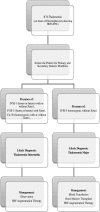Laboratory diagnosis for thalassemia intermedia: Are we there yet?
- PMID: 30221402
- PMCID: PMC6430353
- DOI: 10.1002/jcla.22647
Laboratory diagnosis for thalassemia intermedia: Are we there yet?
Abstract
Background: Differentiation between thalassemia major and thalassemia intermedia at presentation is not uniformly characterized, for which an absolute criteria needs to be developed. This study investigated the primary and secondary genetic modifiers to develop a laboratory finding by forming different genetic mutational combinations seen among thalassemia intermedia patients and comparing them with thalassemia major.
Methods: This cross-sectional study analyzed 315 thalassemia intermedia patients. One hundred and five thalassemia major patients were recruited on the basis of documented evidence of diagnosis and were receiving blood transfusion therapy regularly. Various mutational combinations were identified, and comparison was performed between thalassemia intermedia and major using statistical software STATA 11.1.
Results: The mean age of the total population was 5.9 ± 5.32 years of which 165 (52%) were males. Of the two groups (thalassemia intermedia and thalassemia major), IVSI-5, IVSI-1, and Fr 8-9 were more prevalent among the thalassemia intermedia cohort. When comparison was performed between the thalassemia intermedia and thalassemia major patients, it showed significant results for the presence of Xmn-1 polymorphism.
Conclusion: The presence of IVSI-5 homozygous with Xmn-1, IVSI-5 heterozygous with Xmn-1, Cd 30 homozygous with or without Xmn-1 and IVSI-1 homozygous or heterozygous either with or without Xmn-1 prove to be strong indicators towards diagnosis of thalassemia intermedia.
Keywords: Xmn1 polymorphism; genetic modifiers; genetic mutational combinations; product transfusion; thalassemia.
© 2018 Wiley Periodicals, Inc.
Figures
Similar articles
-
The Effect of Xmn -1 Polymorphism and Coinheritance of Alpha Mutations on Age at First Blood Transfusion in Iranian Patients with Homozygote IVSI-5 Mutation.Int J Hematol Oncol Stem Cell Res. 2022 Jan 1;16(1):47-54. doi: 10.18502/ijhoscr.v16i1.8441. Int J Hematol Oncol Stem Cell Res. 2022. PMID: 35975115 Free PMC article.
-
Beta-thalassemia intermedia from southern Iran: IVS-II-1 (G-->A) is the prevalent thalassemia intermedia allele.Hemoglobin. 2002 May;26(2):147-54. doi: 10.1081/hem-120005452. Hemoglobin. 2002. PMID: 12144057
-
Phenotype score to grade the severity of thalassemia intermedia.Indian J Pediatr. 2003 Jun;70(6):477-81. doi: 10.1007/BF02723137. Indian J Pediatr. 2003. PMID: 12921315
-
Thalassemia intermedia.Haematologica. 1995 Jan-Feb;80(1):58-68. Haematologica. 1995. PMID: 7758995 Review.
-
Molecular basis of asymptomatic beta-thalassemia major in an African American individual.Am J Med Genet. 1997 Mar 17;69(2):196-9. Am J Med Genet. 1997. PMID: 9056561 Review.
Cited by
-
Thalassemia in Sub-Saharan Africa: epidemiology, diagnosis, and management - a narrative review.Ann Med Surg (Lond). 2025 Apr 10;87(6):3523-3536. doi: 10.1097/MS9.0000000000003270. eCollection 2025 Jun. Ann Med Surg (Lond). 2025. PMID: 40486599 Free PMC article. Review.
References
-
- Chernoff AI. The distribution of the thalassemia gene: a historical review. Blood. 1959;14(8):899‐912. - PubMed
-
- Vichinsky EP. Changing patterns of thalassemia worldwide. Ann N Y Acad Sci. 2005;1054(1):18‐24. - PubMed
-
- Ahmed S, Saleem M, Modell B, Petrou M. Screening extended families for genetic hemoglobin disorders in Pakistan. N Engl J Med. 2002;347(15):1162‐1168. - PubMed
MeSH terms
LinkOut - more resources
Full Text Sources
Other Literature Sources


